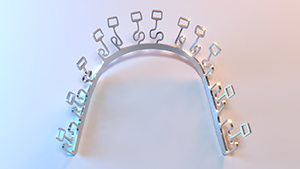Life with BRIUS®

BRIUS needs your care and cooperation to deliver the best results. Please be sure to follow the guidelines we provide, so your BRIUS treatment can be as effective and efficient as possible!

Home Hygiene
Brushing and Flossing with BRIUS
BRIUS is positioned behind the teeth and away from tooth contact points. This means you can brush and floss normally with BRIUS. We recommend brushing three times a day for two minutes each, with an electric toothbrush.
Please make sure to use a soft toothbrush and always brush gently along your gum line. Brush each tooth separately for three to four seconds on each surface. Angle the brush upward for upper teeth and downward for the lower teeth.
Rinse vigorously with water and check your work in the mirror: look for any remaining food, plaque, or debris.
In contrast to conventional braces, BRIUS allows you to floss normally, since there are no wires to block the gaps in your teeth. We recommend using fluoridated floss. You should floss first thing in the morning and at least twice during the day — usually after meals.
We also recommend using an electric toothbrush and a water flosser (such as Waterpik® or Philips®) to complement your regular brushing and flossing routine.
Mouthwash with BRIUS
Use over-the-counter fluoride rinses before going to bed and when you wake up each day to keep the bacteria load in your mouth under control and help strengthen your tooth surfaces.
Eating with BRIUS
Food limitations with BRIUS are similar to those with regular braces. On the day you get your BRIUS, eat foods that do not require chewing, such as mashed potatoes, ice cream, protein shakes, noodles, etc. From the second day to the end of treatment, you can return to your normal diet, but avoid any food that is especially hard, crunchy, or sticky.
If you would like to enjoy raw carrots or apples, for example, cut them into thin slices. If you must have ice in your mouth, use small chips, not cubes. Cut meat from bones to avoid popping the brackets off when you bite into ribs and such.
Never open nuts with your teeth. You can chew artificially sweetened soft gum (preferably containing Xylitol) with BRIUS, but please avoid gum that is hard to chew and particularly sticky, or contains sugar.
Talking with BRIUS
BRIUS can alter your speech and give you a lisp for the first week or two of treatment. Your tongue may get sore, and you might find it difficult to speak the way you did before BRIUS.
This impact is only temporary. After the first week or two, your tongue will learn how to deal with the appliance and your speech will return to normal.
Loose Teeth with BRIUS
It is completely normal for teeth to feel loose during braces or BRIUS treatment. Like braces and aligners, BRIUS must first loosen your teeth in order to move them.
Once your teeth reach their final position, they will no longer be loose, because new bone will be set around them by your body.
Playing Sports with BRIUS
BRIUS is installed behind the teeth and away from impact. Since BRIUS connects the teeth through the stabilizing bar, forces of impact can be dissipated by BRIUS, which acts like a shock absorber.
However, we still recommend using over-the-counter or custom-made thermoplastic mouthguards if you play contact sports while wearing BRIUS.
Playing Musical Instruments with BRIUS
When you first start treatment, BRIUS may alter your experience with instruments such as the trumpet. Your teeth and tongue might become sore, and you might find it difficult to recreate the notes you played before BRIUS.
All of this will be temporary. Your teeth and tongue will be sensitive at first, so you may have to stop playing for a week until the soreness is gone. Then you can practice, practice, practice!




